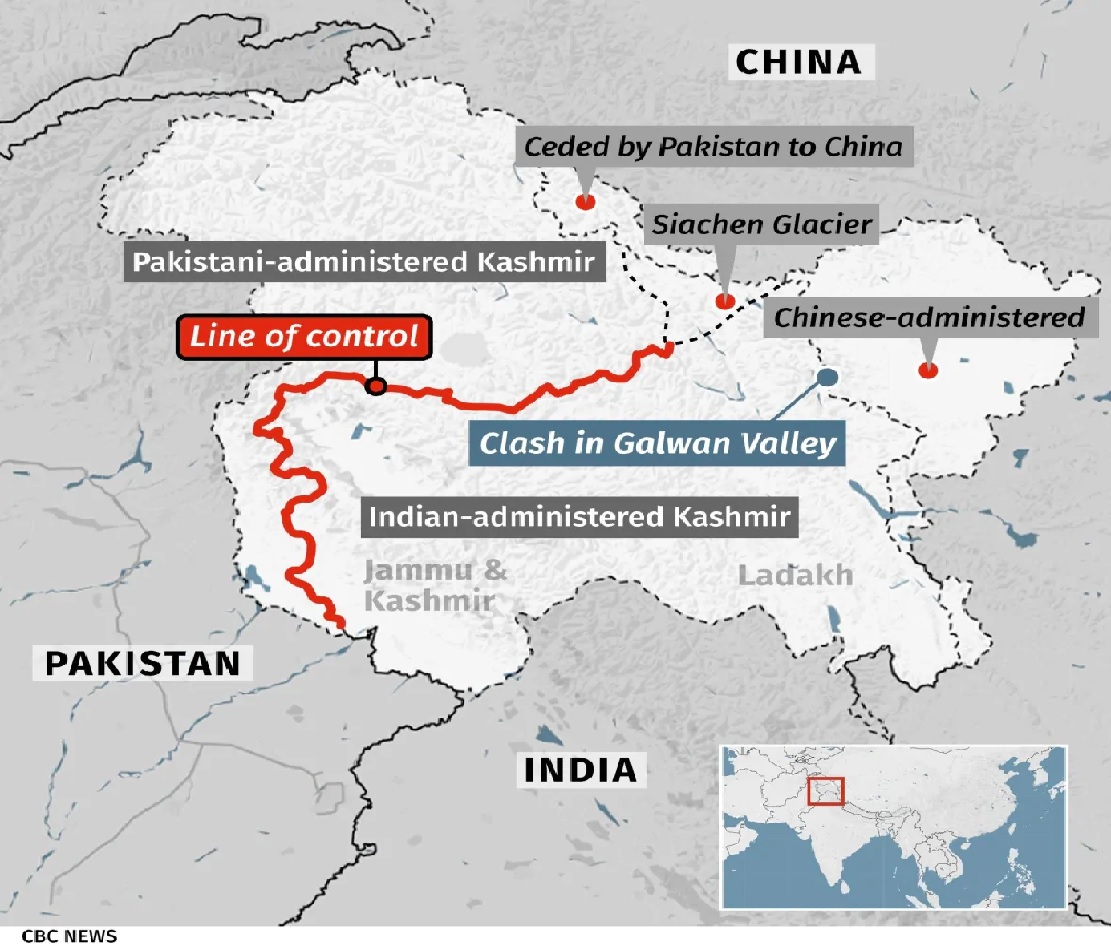China–India deadly border clash: Canadian analysts’ view
A long-standing dispute over the border between China and India has erupted in another violent clash, this time deadly. Initial reports said three Indian soldiers including an officer had been killed but that has now been increased to 20 dead, and possibly some taken prisoner in the high altitude sub zero conditions. It is presumed there were deaths and injuries on the Chinese side although there’s no official word.
Both sides are accusing the other of incursions into their territory and provocations.
There have been a series of small-scale violent physical brawls between the two armies in the past few years but this is the first time in some 45 years that there have been deaths. There was no gunfire and such incidents have typically involved rocks, clubs and fists.

CBC News
The ill-defined 3,488 kilometre border through rugged and inhospitable mountainous territory is guarded by troops of both countries on either side of what is called the Line of Actual Control which has been created along both Chinese and Pakistani controlled areas. Talks to settle the dispute with China have been ongoing for years and the latest incident occurred even as higher level military talks to de-escalate were ongoing.
India’s north borders on both China and Pakistan, and all three countries are extremely protective of their borders, actual or perceived. India has had bitter wars with both.
Indian army soldiers rest next to artillery guns at a makeshift transit camp near Baltal, southeast of Srinagar, before heading to Ladakh on Tuesday. (Reuters)
Christian Leuprecht is a political science analyst at the Royal Military College and at Queen’s University in Kingston Ontario. He notes that India and China are rivals for power and influence, and India is also concerned that Pakistan plays a role in China’s strategic and economic ‘belt and road’ initiative and as such feels increased threat on both borders and feels vulnerable.
Leuprecht also says China will seize any opportunity to distract from the coronavirus, “China wants to be seen as strong and it knows India can ill afford to militarize the conflict. By what appears to be bludgeoning three Indian soldiers to death, China is sending a signal that it will stand its ground. Such an operation must have been authorized by the Chinese chain of command, likely from Beijing, because it constitutes about as serious an escalation as one can imagine without actually firing shots. But China is clearly looking to put Prime Minister Modi in his place in an attempt to preserve the status quo”.
While the tension has risen, analysts doubt either side wants to escalate to an actual shooting war.
Colin Robertson, a former Canadian diplomat to China and the U.N. says the incident is nevertheless serious noting any conflict with nuclear powers involved is dangerous .
He says its another signal of Chinese leader Xi’s “pushing the envelope on its territorial claims across the Indo-Pacific in recent weeks”.
Robertson points out the Chinese have sunk a Vietnamese fishing boat in the South China Sea, swarmed a Malaysian offshore oil rig, menaced Taiwan and is now tightening its grip on the semi-autonomous region of Hong Kong.
Shuvaloy Majumdar served as the policy director to successive Canadian foreign ministers, as well as senior policy advisor in international development, He is a Munk Senior fellow at the Macdonald Laurier Institute think tank. He said, “There is no equivalence between India and China in this dispute. China’s provocative military build up along the border in Ladakh, and recent games testing the limits of Indian sovereignty, have now resulted in the end of 40 years of stability.”
He added, “With twenty members of the Indian Forces who reportedly died defending their territorial integrity, Canadian leaders would be wise to stand alongside their Indian counterparts, condemn China’s aggression, take steps toward deepening cold climate military cooperation, and call upon China to demilitarize and deescalate the situation China created”.
In May, Chinese soldiers reportedly crossed the border at three separate areas in the Ladakh region near Tibet erecting tents and guard posts resulting in a physical confrontation.
The Chinese military says it can deploy thousands of soldiers and weapons from central China to the border with India “within hours”. Only last week the tow countries has said they had reached a consensus following a May incident (Photo: Weibo- via SCMP)
China is also flexing its muscle and pushing its control over the sea, having deployed a network of sensors and communications across the northern portion of the South China Sea.
Called the “Blue Ocean Information Network’ it is labeled by the Chinese as a demonstration system ostensibly for environmental monitoring and communication.
The Centre for Strategic and International Studies notes in a brief by the Asia Maritime Transparency Initiative that there are several fixed and floating platforms involved in the system which China is planning to expand to the rest of the South China Sea, the East China Sea and “other ocean territories far from Chinese territory”
The brief says of this system, “the military utility of its sensing and communications functions makes its development important to monitor.
Additional information-sources
- BBC: S Biswas: Jun 16/20: Kashmir clash- 20 Indian troops killed in fighting with Chinese forces
- NY Times: Gettleman/Kumar/Yasir; Jun 16/20: 20 Indian soldiers killed in deadly border clash with China
- SCMP: K.Purohit: Indian army says 20 of its soldiers killed in border clash with Chinese troops
- Associated Press (via CBC): Jun 16/20: 20 Indian soldiers killed in confrontation with China in Himalyas
- Al Jazeera: jun 16/20: India says 20 soldiers killed in border clash with China
